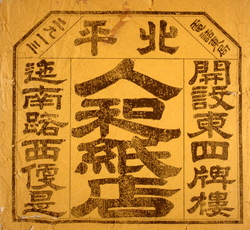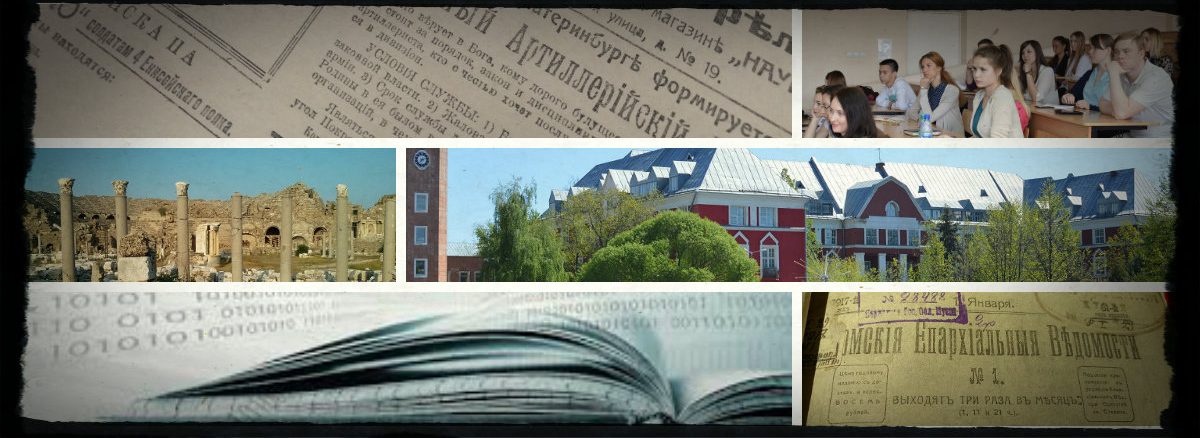The paper gods collected on this Web site were donated by Anne S. Goodrich (July 1895–April 2005) to the C. V. Starr East Asian Library in 1991, approximately sixty years after she purchased them. At the time of the purchases, she was working as a missionary in what was then called Peking. She had been born in China, and she returned after receiving her education in the United States, an education that included graduate work at Columbia University's Teachers College. Also working in China as a missionary was her future husband, L. Carrington Goodrich, who eventually became chairman of the growing young Department of Chinese at Columbia University, which eventually became the Department of East Asian Languages and Cultures. Together and separately the two donated many interesting artifacts from their years in China.
It is a mark of Anne Goodrich's intellectual curiosity that the folk religion of the people she worked among so intrigued her. Her interest in the paper gods she saw in the homes of acquaintances led her to learn all she could of the local folk religions. She began by purchasing everything that was in the store called Ren he zhi dian 人和紙店 (Unity Among Men Paper Shop).
She spent much of her long life answering for herself many of the questions raised by Chinese culture, and as a result she published a three-volume study: The Peking Temple of the Eastern Peak: The Tung-yüeh Miao in Peking and its Lore (Monumenta Serica, 1964); Chinese Hells: The Peking Temple of Eighteen Hells and Chinese Conceptions of Hell (Monumenta Serica, 1981); and Peking Paper Gods: A Look at Home Worship (Monumenta Serica, 1991). When she finished her last book, she donated to the Library the primary resources she had studied in order to write it. These are the paper gods featured on this Web site. However, she was well aware that hers was not the last word, and that many questions remained. Her donation was intended to provide other scholars she viewed as more accomplished than herself with the primary resources to delve into this important aspect of lives as they were lived in early twentieth-century China.
This Web site is offered in the hope that scholars with similar curiosity about these images and the worldview they represent will continue the study and deepen our understanding about their significance. Questions and suggestions concerning the site are welcome.
Welcome to the Archive of the Columbia Daily Spectator, the newspaper of Columbia University and Morningside Heights and the second-oldest college daily paper in the country. When completed, the Archive will include the complete run of the newspaper from 1877 to the present. Currently available content may be viewed via the Browse By Date page. For articles published in the last 15 years, see also the main Spectator website.
Whenever possible pages have been scanned from original paper copies and digitized using state of the art technology that provides full-page, searchable reproductions of articles, photographs, and advertisements.
The goals of the Archive are to provide a public resource for Columbia University history and to preserve the Spectator's past work. It is the result of a partnership between the Spectator and Columbia University Libraries, and funded jointly by the Libraries and through generous gifts from Spectator alumni and friends, especially members of the class of 1958. (See also the Acknowledgementspage.)
Columbia Library Columns was published from 1951 to 1996. It was edited by Roland Baughman, Head of Columbia's Dept. of Special Collections, until his death in 1967; then by Kenneth A. Lohf, until his retirement in 1992; then, briefly, by Jean Ashton and Michael Stoller. Its final issue was Autumn 1996.
The digitized collection comprises some 6,900 pages in 46 volumes (135 issues).
Over the years contributors included faculty, University adminstrators, writers, historians and collectors, as well as Columbia librarians. Articles focused on individual collections, special acquisitions, literary topics and issues relating to the growth of Columbia's libraries and special collections generally.
The Barbara Curtis Adachi Collection, given to Columbia's C. V. Starr East Asian Library in 1991, is one of the most extensive collections in the world visually documenting this rich performance tradition. The collection represents four decades of close contact and respectful collaboration between Ms. Adachi and the Japanese National Bunraku Troupe, the leading performance group of Bunraku in the world, and documents the significant revival of Bunraku's popularity in the second half of the twentieth century.
The Robert Biggert Collection of Architectural Vignettes on Commercial Stationery was donated to the Avery Architectural and Fine Arts Library by Robert Biggert in honor of Lisa Ann Riveaux. This unique collection of printed ephemera contains over 1,300 items with architectural imagery spanning the dates 1850 to 1920, in more than 350 cities and towns in forty-five states, as well as the District of Columbia and U.S. possessions. New York City is particularly well-represented with over 100 items portraying structures below Houston Street alone.
The collection's billheads, letterheads, envelopes, checks, and business cards document the rise of the United States as an industrial nation, in often elaborate vignettes of factories, warehouses, mines, offices, stores, banks, and hotels. Industries range from livestock, textiles, printing, roofing, and brewing to wagon works, cordage, and merchandising. The collection presents a unique view of the emerging American industrial scene with illustrations of buildings rarely illustrated elsewhere, including many buildings that have been demolished.
The material offers a wealth of possibilities for architectural historians, as well as students of commerce and graphic design. There are numerous images from the same businesses over successive decades, which show how their buildings grew over time in tandem with changes in typographic taste. Robert Biggert has conducted substantive research on the format and design aspects of the stationery vignette. "Architectural Vignettes on Commercial Stationery" by Robert Biggert was first published inJob Printing in America, The Ephemera Journal, Volume 8, 1998 [PDF], a publication of The Ephemera Society of America, Inc.The article provides richly-documented analysis of the graphic design elements, compositions and formats used in commercial stationery over the 70 year period.
The Notable New Yorkers Web site offers audio recordings and transcripts of interviews with ten influential New Yorkers, drawn from the collections of the Oral History Research Office of the Columbia University Libraries. These interviews, conducted by the Office between 1955 and 2001, open an imaginative portal into twentieth-century New York City and the ways in which it has deeply affected the culture and history of the United States and the world beyond. With three background essays and a briefer methodological introduction for each oral history, this site also provides a revealing look at the art of the biographical interview—a methodology developed by the Office over its four and a half decades of existence—in which individuals who have shaped history reflect upon their lives and accomplishments.

